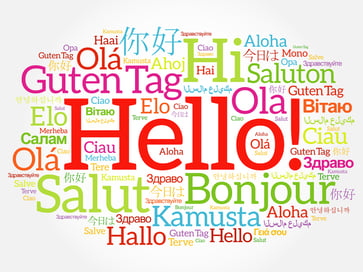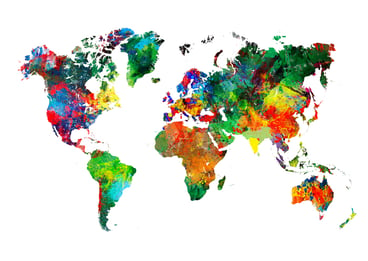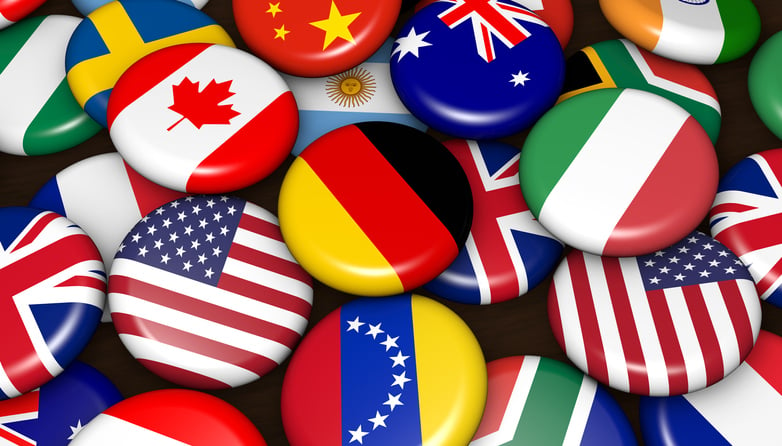The world has never been more connected than it is today. Examples in our personal and professional lives are abundant. My four-year-old daughter, Lanah, practices saying her colors and numbers in Spanish with her grandparents, Ama and Tito, via video call to Ecuador (where my mom retired). I chat with an Amazon customer service representative in Huntington, West Virginia. We’re talking about an order that is delayed in a warehouse in Edison, New Jersey as I last-minute shop from my phone at the airport in Orlando, Florida for a birthday gift for my wife being delivered to our home in Connecticut. And just a few minutes ago, I was in a conversation from my desk on the East Coast of the U.S. with a member of our sales team in France and a member of our Professional Services team in Germany working on a cool, creative automation for a customer in Luxembourg.
Technology has brought us close together and enabled us to do things in real time regardless of location. To businesses this means that access to markets, resources, and employees is better than ever before. But sometimes there is still a noticeable, obvious distance.
The types of distance that impact a global strategy
Distance isn’t just about miles and kilometers – distance reflects everything that makes a location unique. Distance can include:
- Cultural: such as societal norms, language, and even greetings in a business setting
- Government regulations: rules, compliance, and corporate cultures
- Geographic or physical differences: such as time zones, infrastructure, and access to sea ports
- Economic: like the social class/income gap
These differences are the source of both unique opportunities and challenges.
How distance influences DocuWare's global strategy
At DocuWare, we have staff, Partners and customers in the U.S., Europe, Latin America, and Africa. Our company was founded in Germany, so that’s one of the main business cultures that is represented here. Our German colleagues collaborate every day with our marketing, sales, quality assurance, professional services, training, and software support teams in the U.S., as well as with software developers in Bulgaria.
One of my first trips to Bulgaria to meet with some DocuWare team leaders was full of examples of differences in business culture I was not fully prepared for. One of the most frustrating was feeling like we had a hard time communicating. Even though my colleagues’ English was nearly flawless, it felt like we were not connecting on ideas. I later learned that I was picking up on non-verbal body language and interpreting it incorrectly.
In the U.S. we nod our heads up and down to indicate a “yes,” however in Bulgaria it’s completely opposite, where an up-and-down head nod is a “no.” A side-to-side (ear-to-shoulder) nod in Bulgaria is a “yes,” but the closest U.S. head nod (side to side, chin to shoulder) is a “no.” Of course, this is a small thing, but it’s always been a helpful reminder to me that even the smallest differences can have an impact on the way our intentions are interpreted. We have to be extremely careful about what we take for granted when working in other countries.
Examples of global business tactics that missed the mark
Business tactics that work in one country may get lost in translation somewhere else.Creating international strategies and managing international teams doesn’t just mean, “Copy what works in Location A to Location B,” – that’s a recipe for disaster. Rather, you need to ensure that these plans are created in a location-specific context.
 Case in point: the attempt to expand the largest retailer in the world into the European market. In 1998, Walmart opened several stores in Germany as the first step of this initiative. By summer of 2006, after losing hundreds of millions of dollars, Walmart raised the white flag and announced it would be shuttering all its operations in the country. Walmart would later say that their strategy of taking what had worked in Bentonville, Arkansas and applying it in Wiesbaden, Germany simply did not work – and they attributed it to some interesting reasons, like smiles and baggers.
Case in point: the attempt to expand the largest retailer in the world into the European market. In 1998, Walmart opened several stores in Germany as the first step of this initiative. By summer of 2006, after losing hundreds of millions of dollars, Walmart raised the white flag and announced it would be shuttering all its operations in the country. Walmart would later say that their strategy of taking what had worked in Bentonville, Arkansas and applying it in Wiesbaden, Germany simply did not work – and they attributed it to some interesting reasons, like smiles and baggers.
Smiling at customers
Walmart requires its sales clerks to smile at customers. It’s a way to show that employees are friendly and approachable, willing to help you and answer any questions you might have. Walmart’s American managers noticed that many of its employees in their German stores weren’t smiling and didn’t seem friendly or approachable. The American managers reinforced the policy and reminded clerks and greeters about their expectations. But Walmart’s German customers found these smiling employees to be strange and off-putting. Germans don’t usually smile at strangers. In fact, some shoppers interpreted this behavior as flirtatious. It wasn’t a cultural norm in Germany to do this, and the policy completely failed in its intent.
Bagging your own groceries
Another of Walmart’s cultural gaffes was asking its employees to bag groceries for customers. In the U.S. nearly every grocery store will have a clerk ringing up your purchases and another bagging your groceries (or a single clerk doing both). But in Germany (or if you have ever shopped at an Aldi in the U.S.) you are responsible for bagging your own groceries. A lot of shoppers felt uneasy watching a Walmart clerk manhandling their groceries. Again, great intention, but a failure in the cultural context.
Sure, these two things weren’t the only reasons that Walmart wasn’t successful in Germany. For instance, Aldi and Lidl dominate the grocery business in Germany. Even a company with the buying power of Walmart could not compete with the local behemoths. It’s a great example of how “What works in Location A” strategies can easily fail if you neglect thinking in terms of culture.
So how should we think about distance when we are developing strategies to open a new office, or go into a new market, or develop a new product?
CAGE: How a comparative model demystifies developing a global strategy
The CAGE Distance Framework helps businesses and managers think about the factors that influence how a strategy is deployed in one geographic location vs. another. CAGE is an acronym – Cultural, Administrative, Geographic, and Economic – which helps us compare two countries and the differences that may impact a strategy.
|
Cultural Distance |
Administrative Distance |
Geographic Distance |
Economic Distance |
|---|---|---|---|
|
Country Pairs (Bilateral) |
|||
|
|
|
|
|
Countries (Unilateral/ Multilateral) |
|||
|
|
|
|
Source: Wikipedia
How does CAGE help you build a global business strategy?
 Using this model, we can discover areas where we may have either challenges or opportunities based on the four dimensions of the CAGE framework. Let’s pretend that we are a successful coffee shop business. We’ll call it DocuBeans.
Using this model, we can discover areas where we may have either challenges or opportunities based on the four dimensions of the CAGE framework. Let’s pretend that we are a successful coffee shop business. We’ll call it DocuBeans.
Now DocuBeans specializes in some of the best European coffee available. We have shops all over Europe and the U.S., but now we are thinking about entering the Chinese market.
What distance differences might we encounter?
- Cultural: China has long history and connection to their national drink: green tea. Coffee is a luxury item, often associated with style and novelty. Espresso, lattes, and other coffee variations are much more popular than a standard cup of coffee. Over at DocuBeans we also don’t have any native Mandarin or Cantonese speakers.
- Administrative: Our trademark, DocuBeans, may be difficult to register in China; and even more difficult to defend if there are knock-offs. There are completely different regulations for restaurants in China. We need to make sure that our standard operating procedures are compatible with local law. Banking and currency movement also come into play. China has strict financial regulations which may make it difficult for us to move money into and out of the country.
- Geographic: China has a huge tea industry that we can leverage to reduce acquisition and transportation costs. Other areas of Asia are huge coffee producers (the Indonesian island of Java is synonymous with our beloved black brew). Rural areas of China have lower levels of infrastructure development which may result in longer transportation times.
- Economic: The value of the Chinese yuan against the euro is volatile, swinging as much as 50% from its 10-year low in 2009 to its high in 2015. This may make purchasing and revenues unpredictable and our profits may be at the mercy of the value of the currency. The rich/poor gap is pronounced, with GDP per capita in its major cities being up to five times the national average. While a DocuBeans store may be successful in a less affluent part of the U.S., its chances of success in rural China are much smaller. Labor is cheaper in China, so we can leverage that when thinking about how we staff our stores and may be able to offset other costs.
CAGE is simply a way of thinking about location-specific advantages and challenges in four important dimensions. By considering these factors up front, you can plan and strategize effectively and mitigate risks associated with addressing an opportunity in a new location.
The CAGE model in practice at DocuWare
Over the course of the last year I have successfully used the CAGE model at DocuWare when determining worldwide strategies for our Professional Services team. It seems simple enough – in general we are offering the same services around the globe, helping our customers implement DocuWare to streamline their business processes and gain every advantage of our office automation solution. We know how to do that in Americas and Europe, so can’t we just do that anywhere the same way? That answer, as you now know, is a very simple “no.”
Here is how DocuWare applies the CAGE model:
- Cultural: The big one here for us is language. In the Americas, we can do well with English and Spanish-speaking consultants. In much of Europe, we can do business in English and another large part of our customer base is in Germany, Austria and Switzerland where we can do business in German. However, in other parts of Europe our consultants speak local languages, such as French in France.
- Administrative: Many people who do business overseas are familiar with administrative distance. For my Professional Services team it means sometimes having to get work visas to travel to a customer or security clearances to access a government network. For me it means thinking about local currencies vs. the euro (which is the currency DocuWare operates on), and the impact of fluctuations in currency exchange rates in markets in which we operate.
- Geographic: Distance and time play a big part in our strategies. As I mentioned before we have French-speaking consultants who predominately work in France. Those resources could also be required in parts of Canada and Africa – so we have come up with unique strategies to facilitate the time change or the long travel time to get to a customer’s office.
- Economic: Different parts of the world have sometimes dramatically different expectations for the cost of labor, including the highly skilled labor of a technical or business consultant. At the same time labor costs can be dramatically different in different parts of the world. This is something we always look at when we consider our strategies for entering new markets.
Are you ready to start designing your global business strategy? Moving your office automation solution to the cloud enables you to increase business agility and respond more quickly to new opportunities. Download this no-nonsense guide today and learn how to plan your move to cloud office automation. Managing your business processes in the cloud seamlessly connects employees, offices, and customers across the globe. Get your free copy now:




